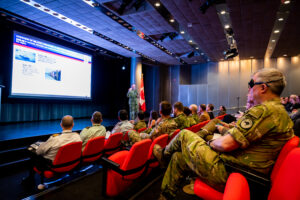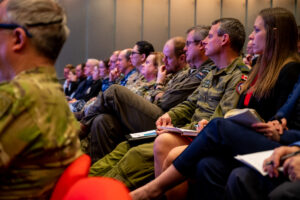




Launched by the Government of Canada in November 2022, Canada’s Indo-Pacific Strategy presents a comprehensive road map to deepen Canada’s multifaceted engagement in the Indo-Pacific over the next decade, by increasing contributions to regional peace and security, strengthening economic growth and resilience, enhancing our significant people-to-people ties, and supporting sustainable development across the region.
This strategy puts forward a clear plan for how Canada will actively work with allies and partners to shape the future of the region, in the midst of a generational global shift, and reinforces Canada’s commitment to a free, open and inclusive Indo-Pacific region.
On January 19, Major-General Mike St-Louis, Canadian Defence Attaché to the United States, provided a briefing to representatives from the U.S. military and diplomatic communities in Washington, DC on the contributions of the Canadian Armed Forces to Canada’s recently published Indo-Pacific Strategy. During the briefing, he highlighted the importance of the strategy for Canada’s future:
As Canadians, we often see ourselves as most integrated with our partners to the South and in Europe. But Canada is also a Pacific nation. Our border to the West stretches along the Pacific Ocean. We have large communities that can trace their heritage to the Indo-Pacific. By 2040 the region will account for half of the world’s GDP. And so, the Indo-Pacific Strategy and the Canadian Armed Forces role within it, will be critical to positioning Canada as a leader in promoting peace and security in the region.
While the Canadian Armed Forces already have a recurring presence in the region through participation in multinational training exercises, transits through the international waters of the Taiwan Strait with Allies through Operation PROJECTION, and support to UN Security Council’s sanctions against North Korea through Operation NEON, the strategy will bolster the Canadian Armed Forces’ presence in the region and enhance Canada’s defence and security relationships with partners and allies.
Specifically, the strategy calls for funding across five key areas:
• $369.4 million to deploy three frigates to the Indo-Pacific on an annual basis;
• $48.7 million to increase Canadian Armed Forces participation in multinational regional exercises;
• $68.2 million to launch a new Canadian Armed Forces capacity building program for the Indo-Pacific;
• $2.6 million to launch new cyber initiatives; and,
• $6.5 million to create new defence positions across the Indo-Pacific.
“Within the $2.3 billion earmarked for the implementation of the overall strategy over the next five years, close to $500 million is dedicated to defence initiatives,” explained Maj. Gen. St-Louis. And for the Canadian Armed Forces:
This means we can do more. We can raise our presence in the region. We can send additional frigates. Our leaders are already looking at new opportunities to work with partners and allies to develop readiness through multilateral exercises. We are also asking ourselves where we can create positions and embed our people within the region to have a permanent presence.
As outlined in the strategy, Canada is engaging in the Indo-Pacific in coordination with our partners, who also recognize the rising importance of the region. Many of Canada’s closest allies, including the United States, the European Union, Germany, France and the United Kingdom, have increased or are considering increasing their presence in the region, guided by their own interests and strategies and based on significant investments in diplomacy, in their military presence, in trade promotion and in development assistance. Within this broader context, Canada has a unique contribution to make based on our particular history and relationships in the Indo-Pacific.
In closing the formal briefing, Major General St-Louis noted that:
As we read the strategy, there is a clear acknowledgment that there is tremendous opportunity in the Indo-Pacific. The strategy aligns our values and interests with tangible resources, objectives and related commitments. It signals Canada’s intent to be an engaged, active, and a reliable partner in the region.
Over 100 representatives from Australia, Canada, Finland, France, Germany, Guatemala, India, Italy, Japan, Korea, Malaysia, New Zealand, Pakistan, Peru, Spain, Thailand, the United-Kingdom, and the United States were in attendance at the formal briefing.
For more information on Canada’s Indo-Pacific Strategy, visit the Government of Canada website here.